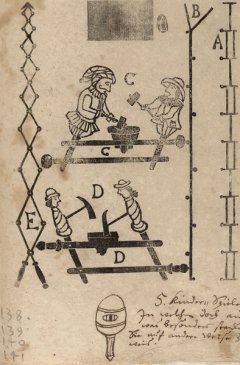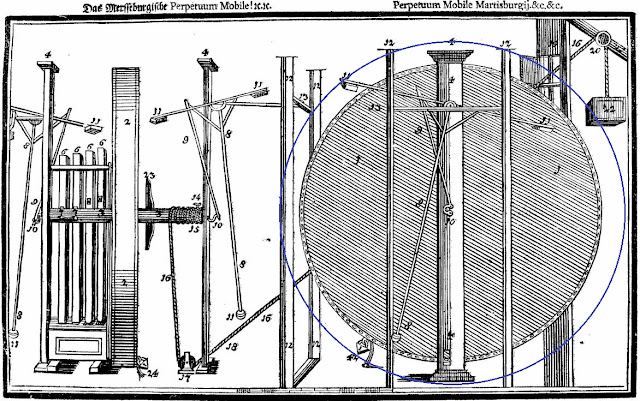On 6th June, 1712, in Germany, Johann Bessler (also known by his pseudonym, Orffyreus) announced that after many years of failure, he had succeeded in designing and building a perpetual motion machine. For more than fourteen years he exhibited his machine and allowed people to thoroughly examine it. Following advice from the famous scientist, Gottfried Leibniz, he devised a number of demonstrations and tests designed to prove the validity of his machine without giving away the secret of its design.
Karl the Landgrave of Hesse permitted Bessler to live, work and exhibit his machine at the prince's castle of Weissenstein. Karl was a man of unimpeachable reputation and he insisted on being allowed to verify the inventor's claims before he allowed Bessler to take up residence This the inventor reluctantly agreed to and once he had examined the machine to his own satisfaction Karl authorised the publication of his approval of the machine. For several years Bessler was visited by numerous people of varying status, scientists, ministers and royalty as well as hundreds of local inhabitants. Several official examinations were carried out and each time the examiners concluded that the inventor's claims were genuine.
Over the years Karl’s health began to deteriorate and his sons decided that it was time for the inventor to leave the castle and he was given five years salary and accommodation in the nearby town of Karlshaven. Despite the strong circumstantial evidence that his machine was genuine, Bessler failed to secure a sale and after more than thirty years he died in poverty. His death came after he fell from a windmill he had been commissioned to build. The windmill was an interesting design using a vertical axle which allowed it to benefit from winds from any directions.
He had asked for a huge sum of money for the secret of his perpetual motion machine, £20,000 which was an amount only affordable by kings and princes, and it’s no coincidence that this sum matched that being offered by the British Government as a reward for the invention of a way to establish a ships longitudinal position at sea. Bessler clearly believed his invention was equal in value. Many people were interested in Bessler’s wheel, but none were prepared to agree to the terms of the deal. Bessler required that he be given the money and the buyer take the machine without viewing the internal workings. Those who sought to purchase the wheel, for that was the form the machine took, insisted that they see the secret mechanism before they parted with the money. Bessler feared that once the design was known the buyers could simply walk away knowing how to build his machine and he would get nothing for his trouble. He said that a bag of money should be put on the table and the buyer could take the wheel there and then. He swore that if he was found cheating he should be beheaded, a not unlikely result if he was found to be a fraud and deceiving his ruler.
I became curious about the legend of Bessler’s Wheel, while still in my teens, and have spent most of my life researching the life of Johann Bessler (I’m now 74). I obtained copies of all his books and had them translated into English and self-published them, in the hope that either myself or someone else might solve the secret and present it to the world in this time of pollution, global warming and increasingly limited energy resources.
Karl the Landgrave of Hesse permitted Bessler to live, work and exhibit his machine at the prince's castle of Weissenstein. Karl was a man of unimpeachable reputation and he insisted on being allowed to verify the inventor's claims before he allowed Bessler to take up residence This the inventor reluctantly agreed to and once he had examined the machine to his own satisfaction Karl authorised the publication of his approval of the machine. For several years Bessler was visited by numerous people of varying status, scientists, ministers and royalty as well as hundreds of local inhabitants. Several official examinations were carried out and each time the examiners concluded that the inventor's claims were genuine.
Over the years Karl’s health began to deteriorate and his sons decided that it was time for the inventor to leave the castle and he was given five years salary and accommodation in the nearby town of Karlshaven. Despite the strong circumstantial evidence that his machine was genuine, Bessler failed to secure a sale and after more than thirty years he died in poverty. His death came after he fell from a windmill he had been commissioned to build. The windmill was an interesting design using a vertical axle which allowed it to benefit from winds from any directions.
He had asked for a huge sum of money for the secret of his perpetual motion machine, £20,000 which was an amount only affordable by kings and princes, and it’s no coincidence that this sum matched that being offered by the British Government as a reward for the invention of a way to establish a ships longitudinal position at sea. Bessler clearly believed his invention was equal in value. Many people were interested in Bessler’s wheel, but none were prepared to agree to the terms of the deal. Bessler required that he be given the money and the buyer take the machine without viewing the internal workings. Those who sought to purchase the wheel, for that was the form the machine took, insisted that they see the secret mechanism before they parted with the money. Bessler feared that once the design was known the buyers could simply walk away knowing how to build his machine and he would get nothing for his trouble. He said that a bag of money should be put on the table and the buyer could take the wheel there and then. He swore that if he was found cheating he should be beheaded, a not unlikely result if he was found to be a fraud and deceiving his ruler.
I became curious about the legend of Bessler’s Wheel, while still in my teens, and have spent most of my life researching the life of Johann Bessler (I’m now 74). I obtained copies of all his books and had them translated into English and self-published them, in the hope that either myself or someone else might solve the secret and present it to the world in this time of pollution, global warming and increasingly limited energy resources.
This problem of acceptance by his potential buyers was anticipated by Bessler and he took extraordinary measures to ensure that his secret was safe, but he encoded all the information needed to reconstruct the machine in a small number of books that he published. He implied that he was prepared to die without selling the secret and that he believed that post humus acknowledgement was preferable to being robbed of his secret while he yet lived.
It has recently become clear that Bessler had a huge knowledge of the history of codes and adopted several completely different ones to disguise information within his publications. I have made considerable advances in deciphering his codes and I am cautiously optimistic that I have the complete design.
Johann Bessler published three books, and digital copies of these with English translations may be obtained from the links to the right of this blog. In addition there is a copy of his unpublished document containing some 141 drawings, his account of the search for perpetual motion - and my own account of Bessler’s life is also available from the links. It is called "Perpetual Motion; An Ancient Mystery Solved?"
It has recently become clear that Bessler had a huge knowledge of the history of codes and adopted several completely different ones to disguise information within his publications. I have made considerable advances in deciphering his codes and I am cautiously optimistic that I have the complete design.
Johann Bessler published three books, and digital copies of these with English translations may be obtained from the links to the right of this blog. In addition there is a copy of his unpublished document containing some 141 drawings, his account of the search for perpetual motion - and my own account of Bessler’s life is also available from the links. It is called "Perpetual Motion; An Ancient Mystery Solved?"
Bessler's three published books are entitled "Grundlicher Bericht", "Apologia Poetica" and "Das Triumphirende...". I have called Bessler's collection of 141 drawings his Maschinen Tractate, but it was originally found in the form of a number of loosely collected drawings of perpetual motion designs. Many of these have handwritten notes attached and I have published the best English translation of them that I was able to get. Bessler never published these drawings but clearly intended to do so at some
I and thousands of others around the world believe that Johann Bessler’s claim to have designed and built a perpetual motion machine, or a continuously rotating device enabled purely by gravity, was genuine. The circumstantial evidence is compelling. This device if reconstructed now, could potentially provide cheap clean electricity, and by reducing the need for fossil fuels, provide a huge step forward in reducing carbon emissions in a very short time.
For some ideas about Bessler’s code why not visit my web sites at
www.orffyreus.net. and
JC










